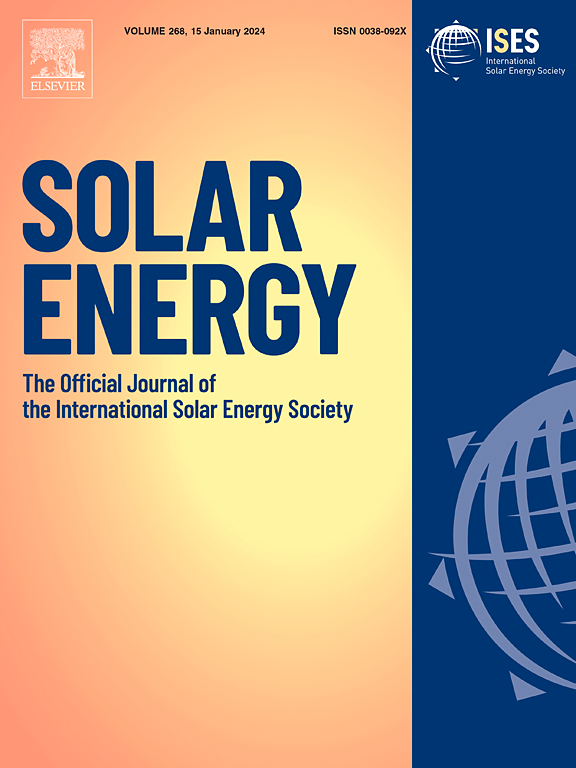Innovative slime-infused glazing systems: energy efficiency, natural lighting, color rendering, and carbon mitigation
IF 6
2区 工程技术
Q2 ENERGY & FUELS
引用次数: 0
Abstract
Heat gain and loss from the building’s windows raise the loads needed for cooling and heating, respectively. This paper introduces an innovative approach to deliver an economical passive energy-efficient glazing solution, making use of various colored transparent slime materials for the first time. This work fills the gap in double-pane glazing with five different colored slime materials: blue (TBS), yellow (TYS), pink (TPS), green (TGS), and colorless slime (TCS), each maintained at different thicknesses (4 mm, 8 mm, and 12 mm). The eighteen samples are analyzed, considering reductions in heat gain, annual cooling expenses, payback duration, carbon emission reduction, Color Rendering Index (CRI), and Correlated Color Temperature (CCT) for Vellore climatic conditions in India. Thermal and daylighting simulations are conducted using Design-Builder simulation tool, incorporating slime glazings into an office complex model. Among the different coloured slime glazings, the transparent yellow slime glazings have shown better thermal performance. The transparent yellow slime glazings, TYS-4, 8, and 12, have the highest annual cooling load reductions of 641.61, 702.05, and 708.37 kWh, respectively, and the shortest payback durations of 2.94, 3.25, and 3.77 years, respectively. They also significantly reduce carbon emissions by 2.5, 2.8, and 2.83 tCO2/year, respectively, when compared to standard DPG-4, 8, and 12. Among TYS-4,8,12, TYS-4 stands out for glazing applications due to its commendable thermal performance and visual quality (CRI > 80). This work reports an innovative, cost-effective solution for energy-efficient glazing, demonstrating the potential benefits of colored slime materials in reducing energy consumption, and carbon emissions.
创新的粘液注入玻璃系统:节能、自然采光、色彩渲染和碳减排
建筑物窗户的得热和失热分别增加了制冷和供暖所需的负荷。本文介绍了一种创新方法,首次利用各种彩色透明粘液材料提供经济的被动式节能玻璃解决方案。这项研究利用五种不同颜色的粘液材料填补了双层玻璃的空白:蓝色(TBS)、黄色(TYS)、粉色(TPS)、绿色(TGS)和无色粘液(TCS),每种粘液的厚度不同(4 毫米、8 毫米和 12 毫米)。在印度韦洛尔气候条件下,对 18 个样本进行了分析,考虑了热增益的减少、每年的冷却费用、投资回收期、碳排放量的减少、显色指数(CRI)和相关色温(CCT)。使用 Design-Builder 模拟工具进行了热能和日光模拟,并将粘液玻璃纳入办公楼综合体模型中。在不同颜色的粘液玻璃中,透明黄色粘液玻璃的热性能更好。透明黄色粘液玻璃 TYS-4、8 和 12 的年制冷负荷减少量最高,分别为 641.61、702.05 和 708.37 千瓦时,投资回收期最短,分别为 2.94、3.25 和 3.77 年。与标准 DPG-4、8 和 12 相比,它们还分别大幅减少了 2.5、2.8 和 2.83 吨二氧化碳/年的碳排放量。在 TYS-4、8、12 中,TYS-4 因其令人称道的热性能和视觉质量(CRI > 80)而在玻璃应用中脱颖而出。这项工作为节能玻璃提供了一种创新、经济的解决方案,证明了有色粘泥材料在降低能耗和碳排放方面的潜在优势。
本文章由计算机程序翻译,如有差异,请以英文原文为准。
求助全文
约1分钟内获得全文
求助全文
来源期刊

Solar Energy
工程技术-能源与燃料
CiteScore
13.90
自引率
9.00%
发文量
0
审稿时长
47 days
期刊介绍:
Solar Energy welcomes manuscripts presenting information not previously published in journals on any aspect of solar energy research, development, application, measurement or policy. The term "solar energy" in this context includes the indirect uses such as wind energy and biomass
 求助内容:
求助内容: 应助结果提醒方式:
应助结果提醒方式:


